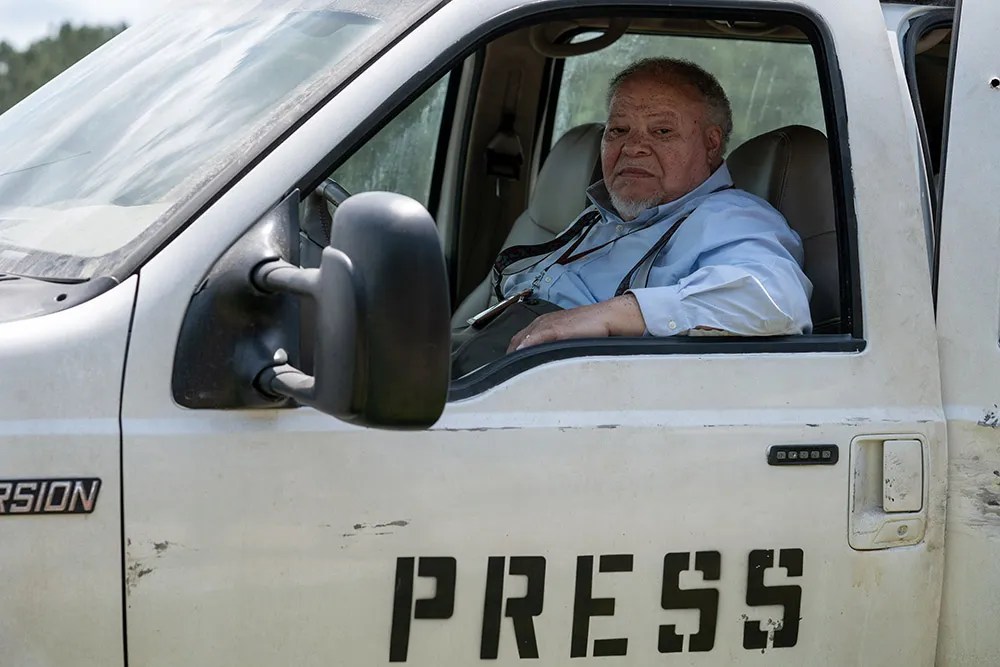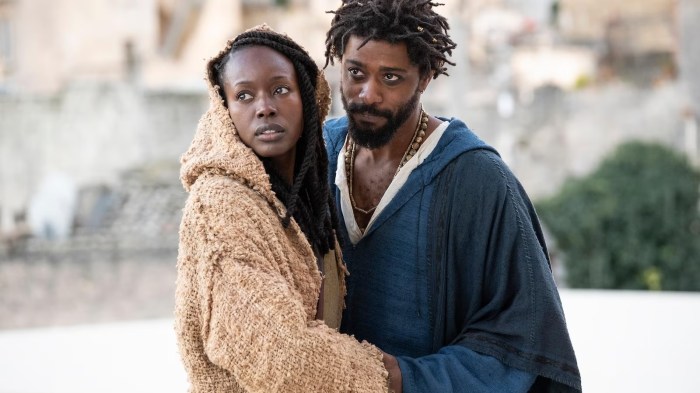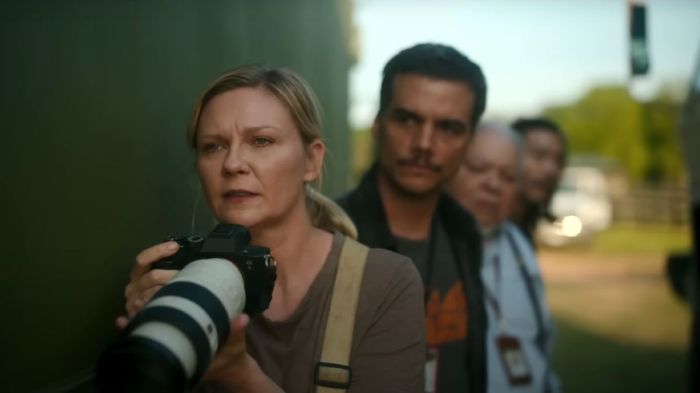Note: This article contains spoilers for the film Civil War.
Director Alex Garland’s film Civil War, which follows a group of journalists through a not-so-distant dystopia in which the country is divided into different factions and people are on the verge of overthrowing the government, was always going to garner controversy. The movie’s politics are vague, and its morality nonexistent, leaving viewers to decide which side aligns with their beliefs. But the most troubling thing about the film is its depiction of who suffers most in America’s wars. While focusing the movie on two white photographers, the film treats the war’s mostly Black, Asian and Latino victims as fodder for the next snap of a camera. In a film full of killings, the most brutal deaths are reserved for non-white characters, particularly Black men.
I didn’t go into Civil War expecting a movie that would leave me pondering the future of this country and its potential descent into fascism. I didn’t expect a politically charged social commentary from a British writer/director who has been adamant about his desire to make a movie about something other than political divisions. The trailer only affirmed those expectations, as any movie in which California and Texas align and secede from the U.S. is more grounded in fiction than any real-life prognostications. I went into Civil War— the No. 1 film at the box office, racking up nearly $50 million in its first two weeks — expecting cool visual effects, sprawling chaos, and inventiveness from the same person behind the groundbreaking horror film 28 Days Later and the sci-fi crowd-pleaser Ex Machina. I also wanted to see some breathtaking action sequences, which the film delivers, especially in the final 30 minutes.
However, as I watched the film, I once again found myself wondering if I should stay or go based on how Black people were depicted on screen.
Related Story
‘American Fiction,’ ‘The American Society of Magical Negroes’ and the endless debate over good Black moviesRead now
About five minutes into Civil War, we get a close-up, slow-motion depiction of a Black man being burned alive. The moment comes as part of a flashback sequence about the main character, Lee Smith (Kirsten Dunst), and her history as a photographer in war-torn countries. The actual burning of the Black man, whom the camera lingers on for an uncomfortable amount of time as his flesh melts away, isn’t necessary. And it’s the most graphic death in the entire movie.
About 20 minutes into the film, there’s another shocking death. This time, it’s a Black member — the only Black member — of an anti-government alliance who is gunned down. But, unlike many other deaths in Civil War, his killing is also drawn out. Other soldiers try to patch him up while blood gushes all over the screen. The purpose of this scene: to focus on the new, young, white character Jesse (Cailee Spaeny) and her journey as a rogue photojournalist. After the shooting she crouches down near the dying man and takes photos. Lee also looks on and, carrying on a visual trope from the movie, we get black-and-white still shots of the dying Black man. Later in the film, Jesse and Lee review the negatives of the incident and revisit the image of the dying man — Lee’s only reaction is that it’s a good photo.
I was aghast at the moment, but I also felt foolish in my disappointment. I should have expected this because to attempt to make a movie about a civil war in an America devoid of politics is actually a political statement itself. It says the Black and Latino people who would likely be the catalysts for this war aren’t worthy of their stories being told. It’s a reminder that Garland, who can conceptualize a world of zombies and sentient artificial intelligence and a raceless civil war, still can’t imagine a fantastical land where those whose suffering is on display for entertainment are always going to be the ones marginalized. Because of this I spent the rest of the film either dreading every time I saw a Black person on screen or wondering when the movie would end so I could find solace elsewhere.
 Stephen McKinley Henderson in Civil War.
Stephen McKinley Henderson in Civil War.
A24
Throughout the duration of Civil War, we see plenty of other dead bodies and fatally wounded characters — a white soldier who gets run over by a truck leaving his brains on the street, and two white men who had been tortured at a gas station. But we also never actually see them get killed. And we don’t endure the level of cold voyeurism we experience during the death of non-white characters.
The killing of a third Black man comes in the film’s most emotional moment as Sammy (Stephen McKinley Henderson), an elderly journalist and the moral center of the movie, is gunned down. The scene is chilling, thanks to a brilliant performance by Jesse Plemons, whose portrayal of a bloodthirsty xenophobe should earn him consideration for awards. However, the moment culminates in two Asian characters and Sammy being killed.
Sammy is killed when a bullet magically misses the main characters in the back seat of the truck he’s driving and hits him in the side. After he succumbs to his injury, the camera slowly lingers on his dead body covered in blood. The last we see of Sammy is Lee going over photo proofs of his corpse before wiping up the blood from the back seat of her car after his body is removed.
The circumstances surrounding Sammy’s death are infuriating and represent some of Civil War’s least logical plot points. His death is a direct result of Jesse’s immaturity as she leaves the group to pull a stunt in a car and disappears. When the group has to find the young journalist, it leads to Sammy’s shooting. And in the aftermath of Sammy’s death, nobody mentions Jesse’s role in getting him killed. Instead, Lee encourages her to find peace in Sammy’s death. There’s no reckoning or even acknowledgment of Jesse’s actions.
Related Story
 ‘The Book Of Clarence’ can’t hold the weight of the icons it invokesRead now
‘The Book Of Clarence’ can’t hold the weight of the icons it invokesRead now
If there’s one bit of realism to take from the moment, however, it’s that Sammy didn’t want to save Jesse but was overruled. Which means we got to see an example of a lone Black journalist in a makeshift newsroom being ignored while warning everyone else about the foreboding terror on the way only to become the victim of everyone else’s terrible decisions.
By the time the actual climactic siege in Washington occurred, I was ready for the movie to end while waiting for any other Black character that flashed on the screen to get executed. Eventually, Dunst’s character, Lee, dies, again by unacknowledged recklessness from Jesse, and the president of the U.S. is executed. Still, their deaths were less gruesome and handled with more care than any of the Black characters who met similar fates. Lee’s death, in particular, comes with zero bloodshed.
When the film ends, it’s clear that the warring sides’ ideologies don’t matter as much as the story of the journalists, which goes back to Garland’s original goals for the project: creating an apolitical and morally neutral version of the fictional civil war.
It’s a journey that always seemed like a fool’s errand. And the way Black characters are demoted to simply Black bodies only accentuates the fact that it’s impossible to tell a story about the country’s dissolution without mentioning race in some way. In refusing to do so, Civil War is just an empty series of gripping visuals and another excuse to dehumanize Black characters through a camera lens.
David Dennis Jr. is a senior writer at Andscape, and the author of the award-winning book “The Movement Made Us: A Father, a Son, and the Legacy of a Freedom Ride.” David is a graduate of Davidson College.



